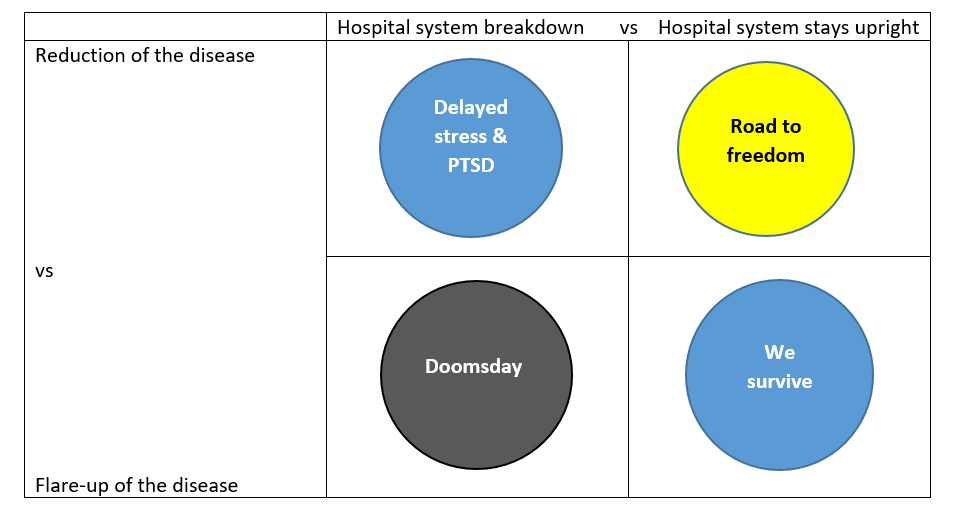Author: Manu Steens
In this article I am writing my own opinion, not that of any organization.
Some time ago I read the book “Handboek Scenarioplanning-Toekomstscenario’s als strategisch instrument voor het managen van onzekerheid” (Handbook Scenario Planning-Future Scenarios as a strategic instrument for managing uncertainty). That book has worked on me like a red rag on a bull. It inspired me to apply the first steps of the procedure discussed in the book. I think that a productive result can be presented very quickly when going through those first steps: a crisis anticipation team can be used in any crisis center. How do I see that? As the procedure prescribes, I start from 2 axes with, in my opinion, a lot of impact and a lot of uncertainty:
Two uncertainties about Covid19 and four future worlds
- Disease flare-up vs further disease decline
- The hospital system breakdown vs the hospital system stays upright
This gives rise to four scenario’ s as follows :
- Further decline of the disease and the hospital system stays upright : “Road to freedom”
- Flare-up of the disease and the hospital system stays upright: “We survive”
- Further reduction of the disease and the hospital system collapses: “Delayed stress and PTSD”
- Flare of the disease and the hospital system collapses: “Doomsday” scenario.
Figure:

Only one scenario has been extensively proclaimed and explained in the media : the “Road to freedom”.
This can be brave, but one lesson identified that can be predicted from this is that a CAT (Crisis Anticipation Team) should work on developing the other 3 scenarios.
At the moment it is known that hospitals are groaning under the load of covid19 . Other illnesses are delayed for treatment. This entails separate future aspects that are already known and recognized in previous waves, and of which we already know that we will be confronted with them:
-> Postponement of non-urgent treatment results in an overrun of the hospital system with severe non-covid19 cases after the covid19 crisis, regardless of which scenario of the 4 we face.
-> After the “Road to freedom” scenario, the scenario “Delayed stress & PTSD” can still occur with a high probability. This with a lower uncertainty of occurrence over time. So it would be logical that society, on a global level, should take measures to this end.
-> This situation can also occur after the “We survive” scenario.
-> I don’t even want to talk about the “Doomsday scenario”, because then there is no workable hospital system left. Although a “Doomsday scenario” may also occur in varying degrees, as a series of slow-falling dominoes in terms of falling short for hands on the beds .
Conclusion
A crisis anticipation team can, in my opinion, devote itself with the greatest efficiency and effectiveness to preparing for a failure of the hospital system, when the hands on the beds start to fall short, for example due to burnout and other work-related illnesses.
In order to find solutions, we have to look thoroughly on the labor market for who can do what. A relaxation in job provision to migrants could possibly help? Those of them with medical experience may be able to contribute to the solutions. Or people who are still studying can, as under part of an internship, deal with the more simple tasks of some professionals who then receive the task of “hands on the bed in ICU.”
I hope I’m wrong. Either way, it will never be easy.
Ultimately, if citizens really want to opt for the “Road to freedom” scenario, they will have to exercise a lot of discipline themselves. Because the virus does not adhere to any rules.

